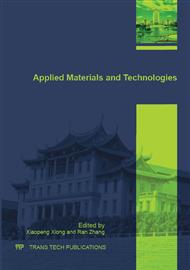p.101
p.107
p.112
p.117
p.122
p.127
p.134
p.141
p.145
Surface Refining by Laser Scanning on Silicon Wafers
Abstract:
A YAG continue-wave laser has been used to refine the surface of silicon wafers in this study. During laser scanning, the irradiated region of the surface of the wafer experienced melting and subsequent recrystallization, which results in a redistribution of metal impurities in the molten pool along the depth direction. Cross-sectional micrographs of irradiated wafers have a clear boundary, which confirms the process of recrystallization, and the depth of molten region depends on the scanning parameters and the size of wafer. Secondary ion mass spectrometry measurements have been carried out to characterize the concentration of metal impurities. After redistribution of metal impurities, a final relative purity region was formed close to the surface. SIMS measurements demonstrate that the metal impurity concentration of the purity region has significantly reduced. The mechanism of the redistribution process of metal impurities in the molten pool has been qualitatively analyzed. All of the experimental results support that the CW laser scanning technology can effectively refine the specific surfaces of silicon wafers, and this technology has a great potential in the field of solar cells.
Info:
Periodical:
Pages:
122-126
Citation:
Online since:
November 2015
Authors:
Keywords:
Price:
Сopyright:
© 2015 Trans Tech Publications Ltd. All Rights Reserved
Share:
Citation:


